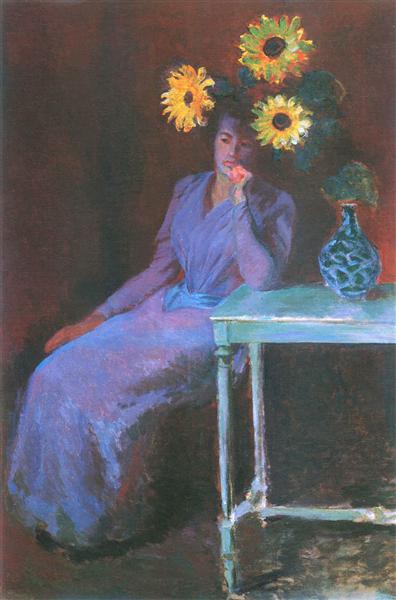Popis
V práci „Portrét Suzanne Hoshede se slunečnicemi“ z roku 1890 zachycuje Claude Monet intimní a osobní okamžik, který odráží jeho vývoj jako malíř a jeho hluboké spojení se světlem a barvou. Tento obraz je součástí řady portrétů, které Monet vyrobil z manželky svého syna Suzanne Hoshedeové, která se během tohoto období svého života stává inspirativní múzou. Jeho výběr slunečnic jako doprovodu ženské postavy nejen poskytuje pulzující kontext, ale také přidává další symboliku do práce.
Na první pohled je práce charakterizována jeho pečlivě vyváženým složením. Suzanne, sedí, nasměruje svůj pohled na diváka a její tvář osvětlená přirozeným světlem, která jemně proniká zleva. Suzanneova uvolněná pozice a klidný výraz přenášejí pocit míru a podrobení kráse přírody, která ji obklopuje. Monet používá překvapivou barvu, kde žlutá pulzující slunečnice kontrastuje a doplňuje nejjemnější tóny jejich světle modrých šatů. Tento kontrast, který je charakteristický pro impresionistický styl, vytváří dynamický vizuální dialog, který udržuje pozornost diváka.
Paleta barev v barvě je bohatá a živá; Použití teplých slunečnic je vyváženo čerstvostí zeleného pozadí a měkkými nuancemi Suzanneho kůže. Monet používá volné a expresivní štětce, které se stávají výraznou pečetí jejich techniky a poskytují texturu a život znázorněným prvkům. Tekutá povaha jeho stylu je v souladu s duchem impresionismu, kde je zachycení světla a atmosféry stejně zásadní jako samotná reprezentace. O tom je doloženo v energetických štětcích, které formují slunečnice, což představuje okouzlující kontrast mezi jasností lidské postavy a nadšením jejich přirozeného prostředí.
Zajímavé je, že se Monet neomezil na zobrazení Suzanne konvenčním způsobem. V tomto portrétu jeho použití přirozeného zeleného pozadí naznačuje harmonickou fúzi mezi postavou a jeho prostředím, praxe, kterou umělec často zkoumal ve své práci. Zahrnutí slunečnic lze také interpretovat jako mrknutí na důležitost každodenního života a krásy, které lze nalézt v jednoduchých okamžicích. Květy nejen zdobí scénu, ale také zaráží postavu Suzanne a vytvářejí atmosféru tepla a blízké.
Ačkoli se práce může na první pohled zdát jednoduchá, je ponořena do složitosti lidských vztahů a studia charakteru. Monet, stejně jako jiní impresionisté, se snažili subjektivně reprezentovat realitu a vykazovat nejen vnější vzhled, ale také emocionální podstatu jejich předmětů. V tomto obraze je jasný záměr zachytit pomíjivou krásu okamžité, začlenit osobní lásku k Suzanne a širší uznání za to, co příroda nabízí.
Závěrem je, že „portrét Suzanne Hoshede se slunečnicemi“ je dílo, které nejen ukazuje technické zvládnutí Monetu, ale také vás vyzývá, abyste přemýšleli o intimitě a spojení, které může existovat mezi umělcem, předmětem a přírodním světem. Prostřednictvím pulzující palety, pečlivé skladby a inovativního využití světla nám Monet nabízí pohled na jeho osobní svět a jeho schopnost najít krásu v každodenním životě a stanovit tuto práci jako pozoruhodný příklad impresionistického hnutí a svědectví o hlubokém dopad, který může mít láska a příroda na umění.
KUADROS ©, slavná barva na vaší zdi.
Ručně vyráběné olejomalby s kvalitou profesionálních umělců a výraznou pečetí KUADROS ©.
Obrázky reprodukční služba se zárukou spokojenosti. Pokud nejste zcela spokojeni s replikou vašeho obrazu, vrátíme vaše peníze 100%.

